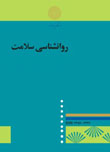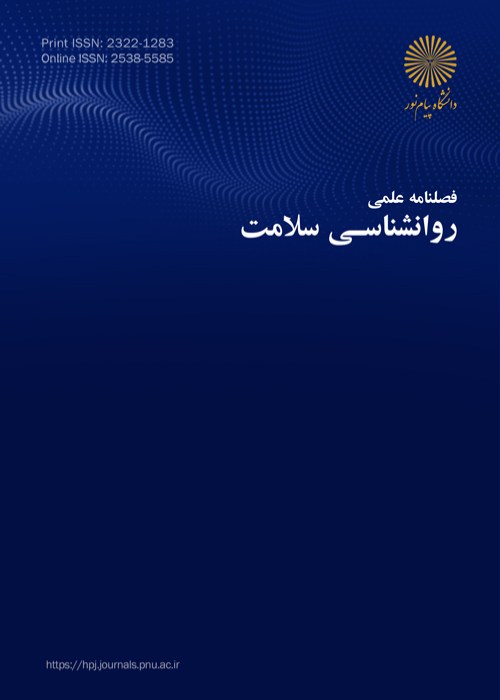فهرست مطالب

فصلنامه روانشناسی سلامت
پیاپی 13 (بهار 1394)
- تاریخ انتشار: 1394/03/18
- تعداد عناوین: 8
-
-
صفحه 5هدف این مطالعه مقایسه باورهای غیر منطقی، خود کارآمدی و بهزیستی روانشناختی در بیماران مبتلا به سردرد های میگرنی و افراد سالم بود. این پژوهش پس رویدادی از نوع(مقطعی – مقایسه ای) است. جامعه آماری این پژوهش را کلیه زنان و مردان مبتلا به سردرد میگرن و کلیه زنان و مردان سالم شهر اردبیل در سال1390 تشکیل می دهند. آزمودنی های پژوهش 30 نفر از مبتلایان به سردرد میگرنی مراجعه کننده به کلینیک های روانپزشکی و مغز و اعصاب شهر اردبیل بود که به روش نمونه گیری در دسترس انتخاب و 30 فرد سالم بود که به شیوه همتا سازی(بر اساس سن، سطح تحصیلات و وضعیت اجتماعی اقتصادی) انتخاب شدند.نتایج نشان داد که بین دو گروه میگرنی و سالم در سه متغیر خود کارآمدی، باورهای غیر منطقی و بهزیستی روان شناختی در سطح (01/ 0≥P) تفاوت معنادار وجود دارد.
کلیدواژگان: خود کارآمدی، باورهای غیر منطقی، بهزیستی روانشناختی، سردرد میگرنی -
صفحه 19مقدمههدف از پژوهش حاضر، بررسی نقش طرحواره های جنسی و تصویر بدنی بر کارکرد جنسی زنان متاهل می باشد.روشجامعه آماری شامل همه زنان متاهل پرستار شاغل در بیمارستانهای دولتی تهران می باشد. 200 نفر به روش نمونه گیری چند مرحله ای انتخاب شدند و مقیاس طرحواره جنسی اندرسن و سیرانوسکی، پرسشنامه تصویر تن فیشر و شاخص کارکرد جنسی زنان را تکمیل کردند. از بین این پرشسنامه ها، 190 پرسشنامه به طور کامل پاسخ داده شده بود و مورد تجزیه و تحلیل قرار گرفتند.یافته هانتایج حاصل از تحلیل رگرسیون نشان داد که بین طرحواره جنسی، خرده مقیاس پرشور – عاشقانه و خرده مقیاس خجالتی – محتاط با کارکرد جنسی رابطه معنی داری وجود دارد، اما خرده مقیاس صریح – راحت با کارکرد جنسی رابطه معناداری ندارد. رضایت بدنی نیز با کارکرد جنسی رابطه معنی داری دارد.نتیجه گیریطرحواره های جنسی و تصویر بدنی می تواند کارکرد جنسی زنان را تعیین کنند.
کلیدواژگان: طرحواره جنسی، تصویر بدنی، کارکرد جنسی، زنان متاهل -
صفحه 63مقدمهپژوهش حاضر با هدف بررسی نقش سبک های مقابله ای و ویژگی های شخصیتی در رفتارهای خوردن آشفته انجام شد.روشبدین منظور، 331 دانشجوی دانشگاه تهران با روش خوشه ایبه عنوان گروه نمونه انتخاب شدند. کلیه شرکت کنندگان به پرسشنامه های نگرش های خوردن، پرسشنامه راهبردهای مقابله ای، و پرسشنامه ویژگی های شخصیتی نئو فرم کوتاه پاسخ دادند. قد و وزن و شاخص توده بدنی اندازه گیری شد. داده ها با استفاده از روش همبستگی پیرسون و روش رگرسیون چندمتغیره مورد تجزیه و تحلیل قرار گرفت.یافته هانتایج بیانگر رابطه معنادار رفتار خوردن آشفته با سبک های مقابله هیجان مدار، مساله مدار، و ویژگی های شخصیتی توافق، نورزگرایی و با وجدان بودن بود. به طوری که نتایج تحلیل رگرسیون نیز حاکی از تبیین 5/ 17 درصد از تغییرات رفتارخوردن آشفته با سبک مقابله ای هیجان مدار، و ویژگی های شخصیتی با وجدان بودن و توافق بود.نتیجه گیریاین یافته ها بیانگر آن است که به واسطه تعامل سبک های مقابله ای و ویژگی های شخصیتی، افراد از رفتارخوردن آشفته به عنوان وسیله ای برای رویارویی با مسایل و مشکلات استفاده می کنند. این نتایج حاصل می تواند در برنامه ریزی پیشگیرانه و شناسایی افراد در معرض خطر و طراحی مداخله های روان شناختی مفید باشد.
کلیدواژگان: رفتار خوردن آشفته، سبک مقابله ای، ویژگی های شخصیتی -
صفحه 114مطالعه حاضر با هدف تحلیل روان سنجی نسخه کوتاه مقیاس مقابله مذهبی (BRCS، پارگامنت، کوینگ و پرز، 2000) در گروهی از بیماران مبتلا به سرطان انجام شد. 155 بیمار سرطانی (119 زن و 36 مرد) به نسخه کوتاه مقیاس مقابله مذهبی پاسخ دادند. به منظور تعیین روایی عاملی نسخه کوتاه مقیاس مقابله مذهبی از روش های آماری تحلیل عاملی اکتشافی و تاییدی و به منظور بررسی همسانی درونی BRCS از ضرایب آلفای کرونباخ استفاده شد. نتایج تحلیل مولفه های اصلی با استفاده از چرخش وریمکس نشان داد که BRCS از دو بعد راهبردهای مقابله مذهبی مثبت و منفی تشکیل شده است. شاخص-های برازش تحلیل عاملی تاییدی بر پایه نرم افزار AMOS، وجود عوامل دو گانه را تایید کرد. مقادیر ضرایب همسانی درونی برای راهبردهای مقابله مذهبی مثبت و منفی به ترتیب برابر با 85/ 0 و 80/ 0 به دست آمد. در مجموع، نتایج نشان داد که در گروه نمونه بیماران سرطانی فارسی زبان، نسخه کوتاه مقیاس مقابله مذهبی، راهبردهای مقابله مذهبی مثبت و منفی را از طریق یک روش کارآمد و از لحاظ روان سنجی و نظری دقیق و معنادار می-سنجد.
کلیدواژگان: نسخه کوتاه مقیاس مقابله مذهبی، ویژگی های روان، سنجی، بیماران سرطانی
-
Page 5The present study aims to compare irrational beliefs, self-efficacy, and psychological well-being in healthy individuals and patients with migraine headaches. This study is a cross-sectional-comparative post event. The statistical universe of this research includes all men and women suffering from migraine headaches, and all healthy men and women in Ardabil in 1390 (A.H.). The subjects were 30 patients suffering from migraine headaches referred to psychological, neurological, and brain clinics selected by convenience sampling method, as well as 30 healthy people selected by cloning method (based on age, education level, and social-economical status. To collect data, the questionnaires of irrational beliefs, self-efficacy, and psychological well-being were used. The results of multivariate analysis of variance (MANOVA) and correlational coefficient showed that there was a significant difference between the two groups "Migraine sufferers and Healthy people" in terms of three variables of "self-efficacy, irrational beliefs, and psychological well-being" in the level of P≥0.01.Keywords: Self, efficacy, irrational beliefs, psychological well, being, Migraine Headache
-
Page 19IntroductionThe aime of the present study is to investigate the role of Sexual Self-Schema and body image on Sexual function of married female nurses.......MethodStatistical population of the present study consist of all married female nurses of Tehran government hospitals. from which 200 individuals were selected by stratified sampling method. They Completed Sexual Self-Schema scale, Fisher Body image Quisetionnier and Female Sexual Function Index. 190 Quisetionnaier were fully answered and were considered......ResultsThe results of the regression analyses revealed that there were significant relationship between Passionate - Romantic and Embarrassed –Conservative subscales and sexual function. Body satisfaction significantly correlated with desirable sexual function........Conclusionfindings showed that Sexual Self-Schema and Body image can predict sexual function.Keywords: Sexual Self, Schema, Body image, Sexual Function, married women
-
Page 63IntroductionThe present study examined role of coping styles and personality traits in eating- disordered behaviors.Method331 students from Tehran university, were randomly selected using cluster sampling method. All participants filled out eating attitudes test (EAT-26), Ways of coping Questionnaire (WOCQ) and Five Factor Personality Inventory (NEO-FFI). Length, weight and body mass index were measured. Data were analyzed using Pearson correlation coefficient, and multivariate regression.ResultsThe results revealed significant correlations between eating- disordered behaviors and Emotion-oriented coping, Task-orientated coping, agreeableness, neuroticism and Conscientiousness Personality traits. Multivariate regression data revealed that Emotion-oriented coping, Conscientiousness and agreeableness Personality traits might explain 17.5% of eating- disordered behaviors variance.ConclusionFindings suggested that individuals develop eating-disordered behaviors as a means of encounter with problems, resulting on interaction between coping styles and personality traits. Findings suggested that individuals develop eating-disordered behaviors as a means of encounter with problems, resulting on interaction between coping styles and personality traits. These results can be helpful in preventive policies, determining high risk individuals and designing of psychological interventions.Keywords: eating, disordered behavior, coping styles, personality traits
-
Page 114The main purpose of the present study was to investigate psychometric properties of the Brief Religious Coping Scale (BRCS, Pargament, Koenig & Perez, 2000) among male and female cancer patients. 155 cancer patients (119 female, 36 male) completed the Brief Religious Coping Scale. The exploratory and confirmatory factor analysis methods and internal consistency coefficients were used to compute the BRCS's factorial validity and reliability, respectively. The results of principal component analysis (PC) with varimax rotation replicated 2-factor structure of positive and negative religious coping strategies for cancer patients. Goodness-of-fit indices of confirmatory factor analysis confirmed the 2 extracted factors for the Brief Religious Coping Scale. Internal consistency coefficients for positive and negative religious coping strategies were 0/85 and 0/80, respectively. In sum, BRCS appears to be a good instrument that does what it was intended to do: assess religious methods of coping in an efficient, psychometrically sound, and theoretically meaningful manner.Keywords: Brief Religious Coping Scale (BRCS), Psychometric Properties, Cancer Patients


